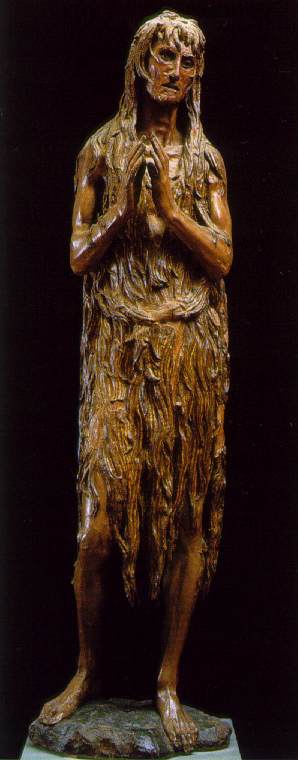If you visit Florence a must see is the Museo dell’Opera del Duomo. This museum is the brainchild of an American art historian and priest Fr. Timothy Verdon. They took an amazing collection of sculpture from the Renaissance which had been stored in a makeshift museum and have them on display in a fantastic design which is inspiring, educational and deeply moving.
One of the highlights is Donatello’s gut wrenching sculpture of the Penitent Magdalene. Illustrating the medieval belief that Mary Magdalene came to France and spent the rest of her days as a penitent hermit, he carves her not as the voluptuous courtesan, but a gaunt, starved old crone wearing rough furs–almost a female John the Baptist.
There is great debate amongst scholars about the true identity of Mary Magdalene. Feminists reject the traditional view that she was a prostitute who repented and turned to Christ. They say that too easily fits the patriarchal narrative about women–that they are either the Virgin-Mother or the whore. They like to point out that having “two Marys” (the blessed Virgin and the Magdalene) is just too convenient and that it completes the myth too neatly. Some feminists have also claimed Mary Magdalene as “the apostle to the apostles” and put her on a pedestal as a sort of feminist prototype–the strong, independent woman who makes her own choices in the face of the male hierarchy. As such she is sometimes also put forward as a patron saint of the proponents of women’s ordination. “Jesus would have ordained her if he were brave enough…” You get the drift.
In fact there is genuine scholarly debate about the true identity of Mary Magdalene. It’s probable that she was simply a well to do respectable woman who was a devout disciple. If you’re interested here’s a summary:
The inaccurate portrayal of Mary Magdalene as a prostitute began after a series of Easter sermons delivered in 591, when Pope Gregory I conflated Mary Magdalene, who is introduced in Luke 8:2, with Mary of Bethany (Luke 10:39) and the unnamed “sinful woman” who anoints Jesus’s feet in Luke 7:36–50. This resulted in a widespread but inaccurate belief that she was a repentant prostitute or promiscuous woman. Elaborate medieval legends from western Europe tell exaggerated tales of Mary Magdalene’s wealth and beauty, as well as her alleged journey to southern France. The identification of Mary Magdalene with Mary of Bethany and the unnamed “sinful woman” was a major controversy in the years leading up to the Reformation and some Protestant leaders rejected it.
Nevertheless, Mary Magdalene as a symbol of penitence strikes the heart because she shows us what we all must be. With the troubles facing our world the only answer is penitence at the foot of the cross. This is one of the key themes in the second half of my book Immortal Combat. Saying “only the penitent man may pass” is a reminder that all our human plans to make ourselves and our church and our world a better place are null and void if they are done simply in our own power. Only with the radical change of mind that comes with repentance can we hope to change.
Donatello’s stark masterpiece teaches us what that means. The Magdalene’s fasting points to the real reason for asceticism–not because the flesh is bad, but because the spirit is better. Her hair shirt and disheveled appearance is a check on human vanity and the subtle lies of having merely an attractive outer facade. Her bare feet, emaciated body and hollow face haunt our imagination like a vision in the night. This is penitence–not just a polite recitation of the naughty things we’ve done, but a profound realization of the heart of darkness and the depth of human depravity and deception.
Mary Magdalene is me. Me too. She reminds us of something the Eastern Orthodox teach: that the soul is closest to God not in moments of ecstatic prayer, intellectual contemplation or spiritual consolations, but at the moment when we really, totally see ourselves and our sin as they really are and turn to God on bended knee and tears and whisper “Lord Jesus Christ, Son of the Living God, Have Mercy on Me A Sinner.”
Mary Magdalene and me too? Finally I can’t forget that most moving moment in Zeffirelli’s Jesus of Nazareth when the Blessed Virgin and the apostle John are making their way to the foot of the cross. Mary Magdalene is trailing alone behind hoping to come with them to see her Lord crucified. The centurion lets the Blessed Virgin and St John through the cordon, but stops Mary Magdalene saying, “Family only.”
The Virgin looks at the Magdalene for a moment and then says so gently to the centurion about the Magdalene…”She is family.”







Wonderful article!! I love this sculpture. St. Mary Magdalene pray for us. Amen.